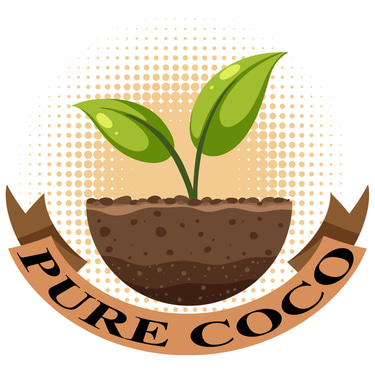Why Gardeners Love Pure Coco Peat: Benefits, Uses & Tips
7/16/20254 min read


Understanding Coco Peat: What It Is and How It's Made
Coco peat, also known as coir pith or coconut coir, is a natural, biodegradable material derived from the husk of coconuts. It serves as a sustainable alternative to traditional peat moss, which is harvested from bogs and can take thousands of years to regenerate. The production of coco peat involves several key processes that transform raw coconut husks into a versatile soil amendment widely used by gardeners and horticulturists alike.
The journey of coco peat begins with the harvesting of coconuts. Once the coconuts are dried, the fibrous husk is separated from the shell. This husk contains coir fibers and coir pith. While the fibers are often used in products like ropes, mats, and brushes, the coir pith is what is processed into coco peat. The husk is first soaked in water, loosening the fibers and allowing for easy separation. Following this, the coir pith is washed to remove any salts and impurities. After washing, it is then dried and ground to produce a fluffy, lightweight material.
One of the most significant properties of pure coco peat is its excellent water retention capabilities. Coco peat can retain moisture and nutrients, making it an ideal growing medium for various plants. It provides an airy structure, promoting healthy root development and allowing for proper aeration in the soil. Furthermore, being a byproduct of coconut processing, coco peat is considered eco-friendly and sustainable. This is in stark contrast to traditional peat moss, which poses environmental risks due to its non-renewable nature. By choosing coco peat, gardeners are not only enhancing their plant's growth environment but also supporting sustainable agricultural practices.
Benefits of Using Pure Coco Peat in Gardening
In the realm of gardening, pure coco peat has emerged as a favored growing medium due to its multifaceted benefits. One of its most prominent features is its exceptional moisture retention capability. Coco peat can retain up to three times its weight in water, allowing gardeners to maintain optimal hydration for plants without constant watering. This quality makes it invaluable for drought-prone areas and for gardeners seeking to reduce water usage while still supporting plant growth.
Another significant advantage is its ability to provide excellent aeration for root systems. The fibrous structure of coco peat allows air to circulate freely, which is crucial for healthy root development. With proper aeration, roots can access oxygen efficiently, promoting stronger plants that are less prone to root rot and other related issues that stem from compacted soil.
Moreover, pure coco peat exhibits a natural resistance to pests and diseases. This intrinsic quality reduces the need for chemical pesticides, making it an eco-friendly option for gardeners. Not only does it help in creating a healthier growing environment, but it also contributes to the overall sustainability of gardening practices.
Another essential factor is the neutral pH level of coco peat, generally ranging between 5.5 to 6.5, making it suitable for a wide array of plants. This neutral pH helps avoid the adverse effects that can arise when using highly acidic or alkaline soils. Additionally, coco peat has a remarkable nutrient-holding capacity, which supports plant growth by retaining essential nutrients, ensuring that they are readily available for uptake by plants.
Overall, the diverse benefits of pure coco peat—from moisture retention and aeration to its natural pest resistance—make it an ideal choice for gardeners aiming for successful growth and sustainable practices.
Common Uses of Coco Peat in Gardening
Coco peat, derived from the husks of coconuts, has gained significant popularity among gardeners, primarily due to its versatile applications and beneficial properties. One of the main uses of coco peat is as a soil amendment for both traditional gardens and container gardening. By incorporating coco peat into garden soil, gardeners can enhance its structure and aeration, leading to improved drainage and root development. This is particularly important in heavy clay soils, where water retention can become an issue. Additionally, coco peat helps to retain moisture, reducing the frequency of watering while providing a consistent moisture level for plants.
Another widespread application of coco peat is as the foundational component in potting mixes. When blended with other ingredients such as perlite or vermiculite, coco peat creates an ideal environment for container plants. It offers a lightweight medium that supports healthy root systems while also serving as an excellent source of organic matter. Common potting mixes that utilize coco peat can be found at garden centers, making it easy for gardeners to source high-quality blends suitable for a variety of plants.
Coco peat is also embraced in hydroponic gardening, where it acts as an effective growing medium for plants. Due to its high water retention capacity and excellent aeration properties, it can facilitate optimal growth in hydroponic systems. Many crops, including tomatoes, peppers, and leafy greens, thrive when cultivated in coco peat, demonstrating its adaptability across various gardening methods. Furthermore, coco peat’s pH-neutral property contributes to its viability as a growing medium, ensuring that essential nutrients remain accessible to plants. Overall, coco peat's diverse applications make it an invaluable resource for both novice and experienced gardeners alike.
Tips for Using and Maintaining Coco Peat in the Garden
To maximize the benefits of pure coco peat in your gardening endeavors, it is crucial to understand how to use and maintain it effectively. The first step involves preparing the coco peat before integration into your growing medium. Begin by hydrating the dry coco peat, allowing it to expand fully. Soaking it in water for several hours ensures that it retains moisture and is ready for use. An additional tip is to break up any compacted clumps to enhance the texture, facilitating easier mixing into your soil.
When it comes to mixing ratios, coco peat should typically be blended with other soil components to create an ideal growing environment. A common recommendation is to use a ratio of 50% coco peat to 50% soil or other amendments such as perlite or vermiculite, which improves aeration and drainage. Adjusting the ratio based on specific plant requirements is advisable; for instance, succulents may benefit from a drier mix, while tropical plants often thrive in a richer, moister blend.
Watering practices are also vital in maintaining the integrity of coco peat. Since coco peat retains moisture effectively, it is essential to monitor the water levels to avoid over-saturation. Utilizing a moisture meter can help determine when additional watering is necessary. It is best to water thoroughly, then allow the soil to dry slightly before the next application. Additionally, to maintain soil quality, consider reusing coco peat after a growing cycle. Thoroughly rinse and dry it before reapplication to eliminate accumulated salts and contaminants. Look for signs indicating when coco peat needs replacement, such as a noticeable odor or a reduction in moisture retention capacity. Regularly assessing these factors will help ensure the longevity and efficacy of your coco peat, benefiting your garden for years to come.
Pure Coco
Explore our range of coco peat products today.
Support
Contact
info@purecoco.com
+91-9015762289
© 2025. All rights reserved.
Support
